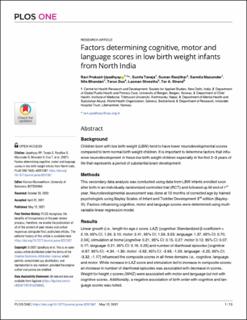| dc.contributor.author | Upadhyay, Ravi Prakash | |
| dc.contributor.author | Taneja, Sunita | |
| dc.contributor.author | Ranjitkar, Suman | |
| dc.contributor.author | Mazumder, Sarmila | |
| dc.contributor.author | Bhandari, Nita | |
| dc.contributor.author | Dua, Tarun | |
| dc.contributor.author | Shrestha, Laxman | |
| dc.contributor.author | Strand, Tor Arne | |
| dc.date.accessioned | 2023-10-31T14:19:46Z | |
| dc.date.available | 2023-10-31T14:19:46Z | |
| dc.date.created | 2021-07-15T11:03:41Z | |
| dc.date.issued | 2021 | |
| dc.identifier.citation | PLOS ONE. 2021, 16 (5), . | en_US |
| dc.identifier.issn | 1932-6203 | |
| dc.identifier.uri | https://hdl.handle.net/11250/3099810 | |
| dc.description.abstract | Background Children born with low birth weight (LBW) tend to have lower neurodevelopmental scores compared to term normal birth weight children. It is important to determine factors that influence neurodevelopment in these low birth weight children especially in the first 2–3 years of life that represents a period of substantial brain development. Methods This secondary data analysis was conducted using data from LBW infants enrolled soon after birth in an individually randomized controlled trial (RCT) and followed up till end of 1st year. Neurodevelopmental assessment was done at 12 months of corrected age by trained psychologists using Bayley Scales of Infant and Toddler Development 3rd edition (Bayley-III). Factors influencing cognitive, motor and language scores were determined using multivariable linear regression model. Results Linear growth (i.e., length for age z score, LAZ) [cognitive: Standardized ẞ-coefficient = 2.19, 95% CI; 1.29, 3.10; motor: 2.41, 95% CI; 1.59, 3.23; language: 1.37, 95% CI; 0.70, 2.04], stimulation at home [cognitive: 0.21, 95% CI; 0.15, 0.27; motor: 0.12, 95% CI; 0.07, 0.17; language: 0.21, 95% CI; 0.16, 0.25] and number of diarrhoeal episodes [cognitive: -2.87, 95% CI; -4.34, -1.39; motor: -2.62, 95% CI; -3.93, -1.29; language: -2.25, 95% CI; -3.32, -1.17] influenced the composite scores in all three domains i.e., cognitive, language and motor. While increase in LAZ score and stimulation led to increase in composite scores; an increase in number of diarrhoeal episodes was associated with decrease in scores. Weight for height z scores (WHZ) were associated with motor and language but not with cognitive scores. Additionally, a negative association of birth order with cognitive and language scores was noted. Conclusions The findings indicate the possible importance of promoting nutrition and preventing diarrhoea as well as ensuring optimal stimulation and nurturance at home for enhancing child development in LBW infants. | en_US |
| dc.description.sponsorship | The original study was funded by Grand
Challenges Canada (Grant Number 0725–03) and
the Research Council of Norway (RCN) through its
Centers of Excellence Scheme (project number
223269). This secondary data analysis was
supported by Centre for Intervention Science in
Maternal and Child Health (CISMAC), Norway
(https://www.uib.no/en/cismac). The funding was
recieved by RPU and SR The funders had no role in
study design, data collection and analysis, decision
to publish, or preparation of the manuscript. | en_US |
| dc.language.iso | eng | en_US |
| dc.publisher | Public Library of Science | en_US |
| dc.relation.uri | https://journals.plos.org/plosone/article?id=10.1371/journal.pone.0251387 | |
| dc.rights | Navngivelse 4.0 Internasjonal | * |
| dc.rights.uri | http://creativecommons.org/licenses/by/4.0/deed.no | * |
| dc.subject | Child Development / physiology, | en_US |
| dc.subject | Cognition / physiology*, | en_US |
| dc.subject | Humans, | en_US |
| dc.subject | India, | en_US |
| dc.subject | Infant, Low Birth Weight / physiology*, | en_US |
| dc.subject | Infant, Newborn, | en_US |
| dc.subject | Language, | en_US |
| dc.subject | Motor Skills / physiology. | en_US |
| dc.title | Factors determining cognitive, motor and language scores in low birth weight infants from North India | en_US |
| dc.type | Peer reviewed | en_US |
| dc.type | Journal article | en_US |
| dc.description.version | publishedVersion | en_US |
| dc.rights.holder | : © 2021 Upadhyay et al. This is an open access article distributed under the terms of the Creative Commons Attribution License, which permits unrestricted use, distribution, and reproduction in any medium, provided the original author and source are credited. | en_US |
| dc.source.pagenumber | 13 | en_US |
| dc.source.volume | 16 | en_US |
| dc.source.journal | PLOS ONE | en_US |
| dc.source.issue | 5 | en_US |
| dc.identifier.doi | 10.1371/journal.pone.0251387 | |
| dc.identifier.cristin | 1921813 | |
| dc.source.articlenumber | e0251387 | en_US |
| cristin.ispublished | true | |
| cristin.fulltext | original | |
| cristin.qualitycode | 1 | |

